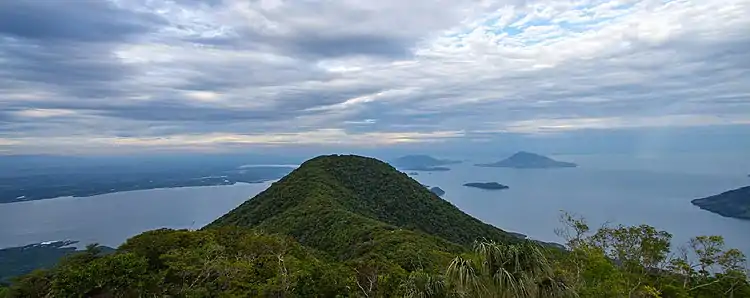Gulf of Fonseca mangroves
The Gulf of Fonseca mangroves ecoregion (WWF ID:NT1412) covers the brackish mangrove forests around the Gulf of Fonseca on the Pacific Ocean. The Gulf is the meeting point El Salvador, Honduras, and Nicaragua. The Gulf is one of the two primary nesting sites of the critically endangered Hawksbill turtle (Eretmochelys imbricata) in the eastern Pacific. In the Honduras portion, there are seven nature reserves that collectively make up a RAMSAR wetland of international importance ("Sistema de Humedales de la Zona Sur de Honduras"), providing protection for migratory birds, sea turtle, and fish.[1][2] [3]
| Gulf of Fonseca mangroves | |
|---|---|
 View of Gulf of Fonseca | |
 Ecoregion territory (in red) | |
| Ecology | |
| Realm | Neotropic |
| Biome | Mangroves |
| Geography | |
| Area | 1,554 km2 (600 sq mi) |
| Country | El Salvador, Honduras, Nicaragua |
| Coordinates | 13.34°N 87.61°W |
Location and description
There are a variety of habitat types on the margins of the Gulf of Fonseca - mangrove forests, mudflats, sandy beaches and rocky cliffs. The mangroves tend to line the lagoons, bays, and flat lowlands. [4]
Climate
The climate of the ecoregion is Tropical savanna climate - dry winter (Köppen climate classification (Aw)). This climate is characterized by relatively even temperatures throughout the year, and a pronounced dry season. The driest month has less than 60 mm of precipitation, and is drier than the average month.[5][6]
Flora and fauna
The most common mangrove tree species in the ecoregion are red mangrove (Rhizophora mangle) and Rhizophora racemosa. Associated species include Avicennia bicolor, and black mangrove (Avicennia germinans)[1]
Protected areas
Officially protected areas in the ecoregion include:
- Estero Padre Ramos Natural Reserve in Chinandega Department of Nicaragua
- Estero Real Natural Reserve in Chinandega Department of Nicaragua
There are also nature reserves along the inlets at Chismuyo Bay, San Lorenzo Bay, Las Iguanas and Punta Condega, Jicarito, and San Bernardo.
References
- "Gulf of Fonseca mangroves". World Wildlife Federation. Retrieved November 20, 2020.
- "Map of Ecoregions 2017". Resolve, using WWF data. Retrieved November 20, 2020.
- "Gulf of Fonseca mangroves". The Encyclopedia of Earth. Retrieved November 20, 2020.
- "Sistema de Humedales de la Zona Sur de Honduras". RAMSAR Sites Information Service. Retrieved November 20, 2020.
- Kottek, M., J. Grieser, C. Beck, B. Rudolf, and F. Rubel, 2006. "World Map of Koppen-Geiger Climate Classification Updated" (PDF). Gebrüder Borntraeger 2006. Retrieved September 14, 2019.CS1 maint: multiple names: authors list (link)
- "Dataset - Koppen climate classifications". World Bank. Retrieved September 14, 2019.